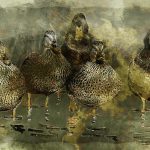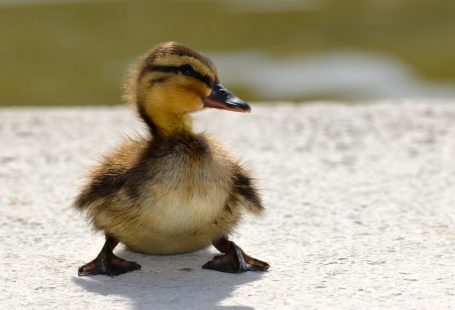There are many choices for wood duck nest boxes. The WDS recommends boxes made of natural wood. Hens accept them well, and they resist heat build-up the best when measured against those constructed with man-made materials. Wood’s natural insulation properties protect eggs during hot, late season incubations. Cedar lumber is recommended because of its ability to resist rot. A construction design which features a side-opening door, such as the one developed by Don Helmeke, allows walk-up monitoring. See
No ladders are needed in this hobby, including during installation of the box. Mount the box on a steel pole or a treated wooden post (never on a tree), with the entrance hole about six feet from the ground. It is very difficult to prevent mammalian predators from eventually accessing a tree-mounted box, and it is easy to accomplish this if the box is mounted on a free-standing, low pole. An effective predator guard installed just beneath the nest box will absolutely prevent access to the box by mammalian predators, egg-eating snakes, and mammalian nest competitors (like squirrels.) A metal, three foot diameter, cone-type guard is strongly recommended and has stood the test of time in many large box units all across the country. The box must be at least nine feet away from a tree trunk and more than eleven feet from an overhanging branch, (see Raccoons and mink eat hens and eggs. Squirrels can and will kill hens that may chance to enter a box where the squirrel has made her nest and is caring for her own litter.
The Minnesota Waterfowl Association (MWA) sells cedar WD nest box kits (Helmeke design) with boards already cut to size. The Prairie Pothole Chapter of the MWA sells the same box kits, and also handles sales of the recommended metal cone predator guards through their website
In the wild, tree cavities may contain only the rotten wood which lines the cavity and its base. Hens bring no additional material into the cavity, initially using only available rotten wood to cover their eggs. As the clutch develops, they gradually add down feathers from their own breast. We must add bedding to our boxes to help entice the hen to use the nest box. Cedar shavings work well for longevity and protection of the eggs. Such products are available as hamster bedding at most pet shops. As an alternative, cabinet shops often will help out by saving shavings from their planers (of various wood types), then donating them for your project.>
Nest boxes can be installed on land or in water. On land, a shoreline installation is fine, but not necessary. Wood ducks have been known to use tree cavities and nest boxes up to a mile away from water. Land-based boxes can be monitored on a walk-up basis, do not require boats or waders, and eliminate worries about varying water levels and bending of poles from ice-out conditions in the north. In teaching situations, it is safer and easier to bring students nose-to-nose with a clutch of eggs using land-based boxes. In all cases, water or land, an effective predator guard below the box is essential and a cone guard is best (see above.) In the South, snakes can slither up a pole and gain access to the eggs. To deter snakes, make sure the cone guard is sealed tightly against the pole (A square piece of 1/4 inch hardware cloth as a screen next to the pole and under the cone will fill a gap if needed.)
When installing a nest box, the compass directions the box faces is probably the least important consideration and should not be the determining factor. Box usage is more likely to be influenced by a smart installation that accomodates the hens’ accessability and flight path to the box. However, we sometimes attempt to do the hen a favor by slightly altering the direction of the nest box opening away from the direction where storm patterns usually develop (locally, northwest and west).
There are no cut-and-dried answers here. In-box cameras demonstrate that wood duck hens will aggressively fight to defend their own nest box when another hen enters. However, they seem to have no problem with other hens nesting nearby. Indeed, multiple nest boxes on a single pole can sometimes be successful. However, we recommend using one box on one pole to prevent the apparent confusion and increased abandonment that have been known to arise with some side-by-side or back-to-back condominium placements. Clustered units, with pole-mounted single boxes spaced as close as 25 feet apart, are generally very successful, but some veteran managers recommend spacing boxes no closer than 50 feet apart. Keep records and see what works best for you.
Facing the nest box opening in a direction to accommodate the hen in her speedy entrance is desirable. However, wood ducks are very agile in flight and can navigate into most cavity/nest box entrances.






